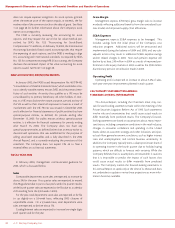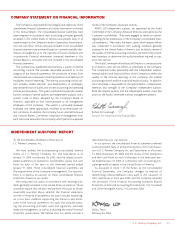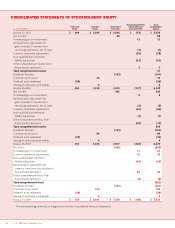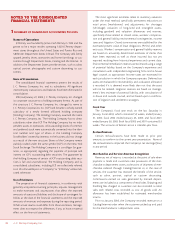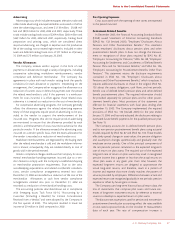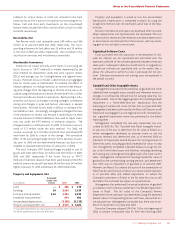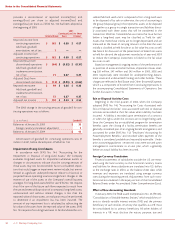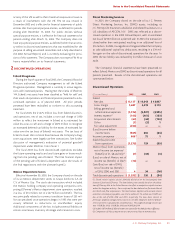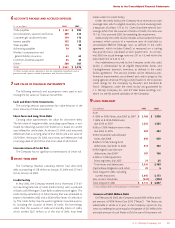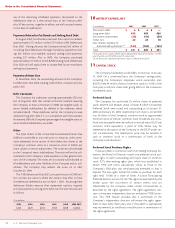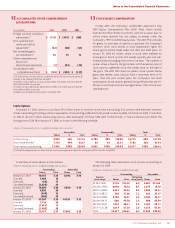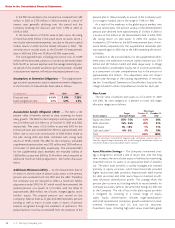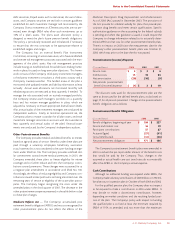JCPenney 2003 Annual Report Download - page 32
Download and view the complete annual report
Please find page 32 of the 2003 JCPenney annual report below. You can navigate through the pages in the report by either clicking on the pages listed below, or by using the keyword search tool below to find specific information within the annual report.
J. C. Penney Company, Inc.30
Notes to the Consolidated Financial Statements
provides a reconciliation of reported income/(loss) and
earnings/(loss) per share to adjusted income/(loss) and
earnings/(loss) per share, as if SFAS No. 142 had been adopted at
the beginning of 2001:
2001
Earnings/(Loss) Per Share
Income/(Loss) Basic Diluted
Reported income from
continuing operations $182 $0.58 $ 0.57
Add back: goodwill
amortization, net of tax 1——
Adjusted income from
continuing operations $183 $0.58 $ 0.57
Reported (loss) from
discontinued operations $(84) $(0.32) $ (0.31)
Add back: goodwill and
tradename amortization,
net of tax 71 0.27 0.27
Adjusted (loss) from
discontinued operations $(13) $(0.05) $ (0.04)
Reported net income $98$0.26 $ 0.26
Add back: goodwill and
tradename amortization,
net of tax 72 0.27 0.27
Adjusted net income $170 $0.53 $ 0.53
The 2003 change in the carrying amount of goodwill for con-
tinuing operations was as follows:
($ in millions) Goodwill
Balance as of January 25, 2003 $35
Foreign currency translation adjustment 7
Balance as of January 31, 2004 $42
Amortization of goodwill for continuing operations was $1
million in 2001, before the adoption of SFAS No. 142.
Impairment of Long-Lived Assets
In accordance with SFAS No. 144, “Accounting for the
Impairment or Disposal of Long-Lived Assets,” the Company
evaluates long-lived assets for impairment whenever events or
changes in circumstances indicate that the carrying amount of
those assets may not be recoverable. Factors considered impor-
tant that could trigger an impairment review include, but are not
limited to, significant underperformance relative to historical or
projected future operating results and significant changes in the
manner of use of the assets or the Company’s overall business
strategies. For long-lived assets held for use, SFAS No. 144 requires
that if the sum of the future cash flows expected to result from
the use and eventual disposition of a company’s long-lived assets,
undiscounted and without interest charges, is less than the
reported value of those assets, an evaluation must be performed
to determine if an impairment loss has been incurred. The
amount of any impairment loss is calculated by subtracting the
fair value of the assets from the reported value of the assets. SFAS
No. 144 requires that a long-lived asset to be abandoned be con-
sidered held and used until it is disposed of. For a long-lived asset
to be disposed of by sale or otherwise, the unit of accounting is
the group (disposal group) that represents assets to be disposed
of together as a group in a single transaction and liabilities direct-
ly associated with these assets that will be transferred in the
transaction. SFAS No. 144 establishes six criteria that must be met
before a long-lived asset may be classified as “held for sale.”
Assets that meet those criteria are no longer depreciated and are
measured at the lower of carrying amount at the date the asset
initially is classified as held for sale or its fair value less costs to sell.
See Note 2 for discussion of the presentation of Eckerd net assets
as held for sale and the adjustment recorded as of year-end 2003
to reduce the Company’s investment in Eckerd to the fair value
less costs to sell.
Based on management’s ongoing review of the performance of
its portfolio of stores and other facilities, impairment losses total-
ing $26 million, $47 million and $42 million in 2003, 2002 and
2001, respectively, were recorded for underperforming depart-
ment stores and underutilized Catalog and other facilities. These
charges are reflected in Real Estate and Other (Income)/Expense,
which is a component of Income from Continuing Operations in
the accompanying Consolidated Statements of Operations. See
further discussion in Note 16.
Exit or Disposal Activity Costs
Beginning in the third quarter of 2002, when the Company
adopted SFAS No. 146, “Accounting for Costs Associated with
Exit or Disposal Activities,” costs associated with exit or disposal
activities are recorded at their fair values when a liability has been
incurred. A liability is recorded upon termination of a contract
or when the rights under the contract are no longer being used.
Since the Company has an established program for termination
benefits upon the closing of a facility, termination benefits are
generally considered part of an ongoing benefit arrangement, and
accounted for under SFAS No. 112, “Employers’ Accounting for
Postemployment Benefits,” and recorded when payment of the
benefits is considered probable and reasonably estimable. Under
prior accounting guidance, certain exit costs were accrued upon
management’s commitment to an exit plan, which is generally
before an actual liability has been incurred.
Foreign Currency Translation
Financial statements of subsidiaries outside the U.S. are meas-
ured using the local currency as the functional currency. Assets
and liabilities for these subsidiaries are translated into U.S. dollars
at the exchange rates in effect at the balance sheet date, while
revenues and expenses are translated using average currency
rates during the reporting period. Adjustments from such trans-
lations are accumulated in the equity section of the Consolidated
Balance Sheets under Accumulated Other Comprehensive (Loss).
Effect of New Accounting Standards
In January 2003, the FASB issued Interpretation No. 46 (FIN 46),
“Consolidation of Variable Interest Entities,” which establishes cri-
teria to identify variable interest entities (VIE) and the primary
beneficiary of such entities. An entity that qualifies as a VIE must
be consolidated by its primary beneficiary. All other holders of
interests in a VIE must disclose the nature, purpose, size and


